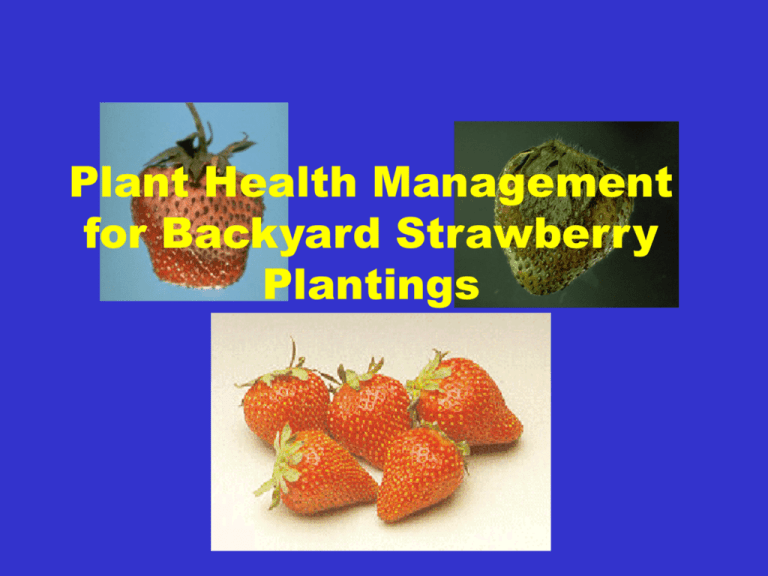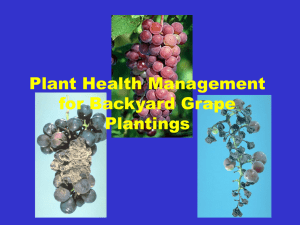Plant Health Management for Backyard Strawberries Planting
advertisement

Plant Health Management for Backyard Strawberry Plantings Prepared by Mike Ellis Professor and Extension Specialist and Omer Erincik Graduate Research Assistant Department of Plant Pathology The Ohio State University OARDC/OSUE Wooster, OH, 44691 Common Diseases on Fruit Gray mold (Botrytis fruit rot) Pathogen: Botrytis cinerea Leather rot Pathogen: Phytophthora cactorum Gray mold Symptoms: gray, dusty-looking fungal growth on ripening berries Early (left) and late (right) stages of botrytis fruit rot on strawberry. Gray mold Disease Development: Most infections occur during bloom. The fungus can infect petals, flower stalks, fruit caps, and fruit. The disease is favored by wet conditions, such as rain, dew, or sprinkler irrigation. The disease is generally most severe in shaded areas where humidity is higher and air movement is poor on berries touching the soil Leather rot Symptoms: On green fruit, brown, firm spots develop. The entire berry may be discolored (brown). On ripe fruit, light to dark purple or brown areas develop. These areas are generally dull in color. Infected fruit have a distinctive bitter taste and unpleasant odor. Leather rot Disease Development: The fungus can infect berries at any stage of development. Disease can develop very quickly during wet conditions. a wet period of two hours is sufficient for infection. Fungus spores are spread by splashing or windblown water from rain or overhead irrigation. the disease is most severe in poorly drained areas in places where berries are in contact with the soil Management of fruit rot diseases Free water (wet conditions) is required for most fungal pathogens to infect fruit. Any practice that promotes faster drying of fruit and foliage is beneficial for disease control. Management of fruit rot diseases Site selection Select a site with good air movement and sun exposure (promote faster drying). Canopy control Control timing and amount of nitrogen fertilizer to prevent excessive growth. Control weeds weeds decrease air circulation. controlling weeds promotes faster drying of fruit and foliage. Mulch Use a layer of straw mulch to create a barrier between fruit and soil. Management of fruit rot diseases Irrigation Irrigate early in the day, so plants dry faster. Handling Pick fruit carefully, avoid bruising Process and or refrigerate fruit immediately after harvest. Renovation Remove old leaves and diseased plant parts after harvest. Common diseases on leaves Leaf spot Leaf scorch Leaf blight Symptoms of leaf diseases Leaf spot Small reddish purple spots develop with tan to grayish white centers surrounded by a purple margin. Leaf scorch Round to angular or irregular dark purple spots or blotches developed. Eventually the entire leaf may turn red. Leaf blight Spots are initially reddish-purple, Later they develop a darker brown or reddish-brown center surrounded with a purple border. Strawberry leaf diseases Disease Development: Leaf spot Pathogen: Mycosphaerella fragariae Infection may occur throughout the growing season. Leaf scorch Pathogen: Diplocarpon earliana Infection may occur throughout the growing season. Leaf blight Pathogen: Phomopsis obscurans Disease is found most commonly on plants after harvest. Management of strawberry leaf diseases Use disease free planting stock Use resistant varieties Proper site selection Choose a site with good air circulation and sun exposure (promotes faster drying). Weed control Weeds decrease air circulation. Controlling weeds reduces drying time of the plants. Remove old foliage just after harvest (renovation) helps to reduce pathogen populations. Common Diseases Attacking Roots Verticillium wilt Red stele Black root rot Verticillium wilt Symptoms: Older leaves turn brown or reddish yellow at the edges, then turn entirely brown and collapse. Roots have areas of dark brown decay. Verticillium wilt Disease Development: Caused by the soil borne fungus Verticillium albo-atrum The fungus can be introduced into uninfested soil on seed, tools, garden machinery and roots of transplants. The fungus can survive in soil for many years. Favored by cool, overcast weather interspersed with warm days. Red stele Symptoms: Many roots may have a rattail appearance, with few or no lateral roots. When infected roots are split, the center core (stele) is brownish or red. diseased healthy Red stele Disease development: caused by a soil borne fungus, Phytophthora fragariae favored by high soil moisture (saturated soil) and cool temperature. most destructive in heavy clay soils that are saturated with water during cool weather. Black root rot Symptoms: Plants are stunded Roots show areas of brown to black discoloration. Eventually, all or part of the main root system is black and dead. Black root rot Disease Development: The disease has been associated with several factors, and is not clearly understood. One or more of the following factors has been associated with the disease: soil fungi, nematodes, winter injury, fertilizer burn, soil compaction, herbicide damage, drought stress, excessive water, improper soil pH. Probably not caused by any single factor. Considered to be a “Disease Complex”. Management of root diseases Use healthy planting stock Use resistant varieties Proper site selection Plant in well-drained soil Select a site that does not have a previous history of problems with any of the root diseases. Rotation Do not replant strawberries where disease has been a problem for at least 2 years. Control weeds Using Fungicides For Strawberry Disease Control Fungicides can be important in commercial strawberry plantings; however, fungicides are generally not recommended for backyard “strawberry” production. Effective fungicides registered for use on strawberry are usually very difficult or impossible for backyard growers to obtain. If not used properly, they are generally not effective. For backyard growers that do wish to use fungicides in the disease management program, fungicide recommendations are available in Bulletin 780 “Controlling Disease and insects In Home Fruit Planting”. Emphasis for disease control in backyard strawberry plantings should be placed on: Use of the various cultural practices for disease control mentioned previously. Use of disease resistant varieties. The most effective method for controlling most strawberry diseases is the use of varieties with good disease resistance. Several strawberry varieties have resistance to many of the common strawberry diseases. The following are some common varieties with multiple disease resistance. Selected literatures for backyard fruit production and plant health management: Bulletin 591. “Growing and Using Fruit at Home” Bulletin 780. “Controlling Diseases and Insects in Home Fruit Planting” Bulletin 861. “Midwest Small Fruit Pest Management Handbook”. These can be obtained through your county extension agent or the Extension Publications Office, The Ohio State University, 385 Kottman Hall, 2021 Coffey Road, Columbus, Ohio, 43210-1044 To get more information about plant diseases visit the websites below. http://www.ag.ohiostate.edu/~plantdoc/extension.php http://www.ohioline.ag.ohio-state.edu






